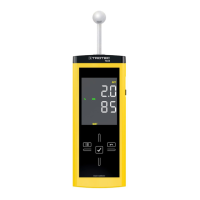EN Operating manual – Material moisture measuring device T660 8
Checking current settings
1. Press the Right/back key (8) for approx. 2 seconds.
– The selected settings are indicated in the two measure-
ment value displays (14, 16).
Measured value storage
Please note that measured values cannot be saved on the device
itself. In order to save measured values, the device has to be con-
nected to a PC via a USB cable using the MultiMeasure Studio
software.
1. Briefly press the OK button (10).
– The displayed measured value will be saved in the soft-
ware.
Further information can be gathered from the help text of the
MultiMeasure Studio software.
USB interface
The device can be connected to a PC via the USB interface (5).
See chapter PC software on page 9.
Switch-off
1. Press and hold the On/Off key (4) for approx. 4 seconds until
a beep is emitted.
– The device will be switched off.
The measurement is effected according to the dielectric measur-
ing principle.
Notes regarding the measurement principle
• The measurement results are only to be used as reference
for a rough orientation.
• An important variable influencing the measured value is the
bulk density of the good to be measured. The higher the bulk
density, the higher the measured value.
• Before measuring, the measuring point is to be cleared of any
impurities (e.g. paint residues, dust).
• If the material to be measured contains metal (e.g. nails,
screws, lines, pipes, etc.) and is situated within the sensor's
measuring field, the measured value skyrockets.
In that event the measurement is not conclusive.
• When the ball head is held to corners (e.g. window frames),
the measured value is generally higher, because there is
more matter in the measuring head's stray field. Toward a
corner a distance of more than 8 to 10 cm has to be ob-
served.
• During the measurement always hold the measuring head (6)
in a vertical position to the measured material, press it to the
surface and do not tilt it.
• Rough surfaces will always result in a too low measured val-
ue.
• Depending on the material's bulk density, the device's impact
depth amounts to 20 to 40 mm. Conclusions regarding zones
located at a lower level cannot be drawn.
• With material thicknesses of less than 20 mm there is a dan-
ger of humidity values from adjacent material layers affecting
the measured value.
• The dielectric measurement method's main area of use con-
sists in comparative measurements at the same construction
material or similar components. Therefore, this method is
well suited for the examination of water damage, leak detec-
tion and the localization of moisture zones for the purpose of
marking the measuring spot for CM measurements.
Measured value assessment for wood
The measurement result is either in the dry or the saturated area.
Saturated means that in addition to the water bound within the
wood there is further liquid. If there is, hence, a measured value
of more than 80, the wood is most like soaked.
Since the measurement value displays of the dielectric measure-
ment method – depending on marginal conditions – are subject
to great fluctuations, a resistance measurement is always prefer-
able, in particular for the determination of wood moisture.
Measuring principle
Display [digit] Wood moisture zone
< 50 digits dry
> 80 digits limit to the saturated range

